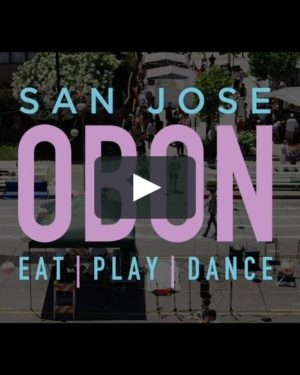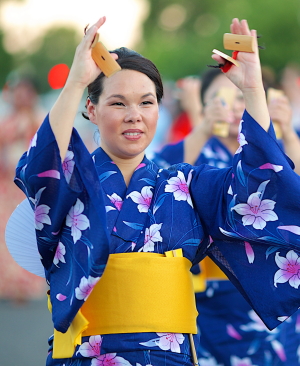MID-JULY through MID-AUGUST: A festival of ancient dances, intricate costumes and a celebration of Japanese culture commences, as the spirit of Obon circles the globe. Worldwide, this festival spans an entire month: “Shichigatsu Bon,” celebrated in Eastern Japan, begins in mid-July; “Hachigatsu Bon” commences in August; “Kyu Bon,” or “Old Bon,” is observed annually on the 15th day of the seventh month of the lunar calendar.
2019 update: According to Japan-Guide.com, the peak of the 2019 Obon travel season is anticipated to take place between August 10 and August 18. The busiest days for domestic travel are expected to be around August 10 (with people leaving the big cities), and August 17-18 (with people returning to the big cities).
Born of Buddhist tradition and the Japanese custom of honoring the spirits of ancestors—Obon is a time for homecomings, visiting family gravesites, dances, storytelling and decorating household altars. Light cotton kimonos, carnival rides and games and festival foods are common at during this season. Obon has been a Japanese tradition for more than 500 years.
ANCESTORS, STORYTELLING & BUDDHISM
“Obon,” from Sanskrit’s “Ullambana,” suggests great suffering, as the full term translates into “hanging upside down.” Bon-Odori—and the Buddhist legend it stems from—recall a disciple of Buddha who used supernatural abilities to look upon his deceased mother. When the disciple saw that his mother had fallen into the Realm of Hungry Ghosts and was suffering, he asked Buddha how he could help her. The disciple made offerings to Buddhist monks who had just completed their summer retreat and, soon after, saw his mother released from the Realm of Hungry Ghosts. With his new-found insight, the disciple suddenly saw the true nature of his mother—her selflessness, and the sacrifices she had made for him—and with extra joy, he danced what is now the Bon-Odori. (Get a Buddhist perspective here.) A primary purpose of Obon is to ease the suffering of deceased loved ones while expressing joy for the sacrifices loved ones have made.

Interested in a peek at last year’s Obon festival in San Jose? Click on the image to view a short video. (Video by Brandon Gregory, courtesy of Vimeo)
A taste of Obon: Looking for recipes to celebrate Japanese culture? The Spruce Eats offers a variety of Japanese cuisine suggestions, suitable for Obon.
The official dance of Obon, though it follows a universal pattern, differs in many details by region. Music and steps typically reflect a region’s history, culture and livelihood. In addition, some regions incorporate items such as fans, small towels or wooden clappers into the dance, while others do not. Nonetheless, everyone is welcome to join in the Bon-Odori dance. When the festival draws to a close, paper lanterns are illuminated and then floated down rivers, symbolizing the ancestors’ return to the world of the dead (Toro Nagashi). Fireworks often follow.
OBON AROUND THE WORLD
Outside of Japan, the festivities of Obon resonate through Brazil—home to the largest Japanese population outside of Japan—as well as in Argentina, Korea, the United States and Canada. In Brazil, street Odori dancing complements the Matsuri dance, and Taiko (drumming) and Shamisen contests are held. Buddhist temples host events throughout the United States, and in Hawaii and California, events are abundant.
